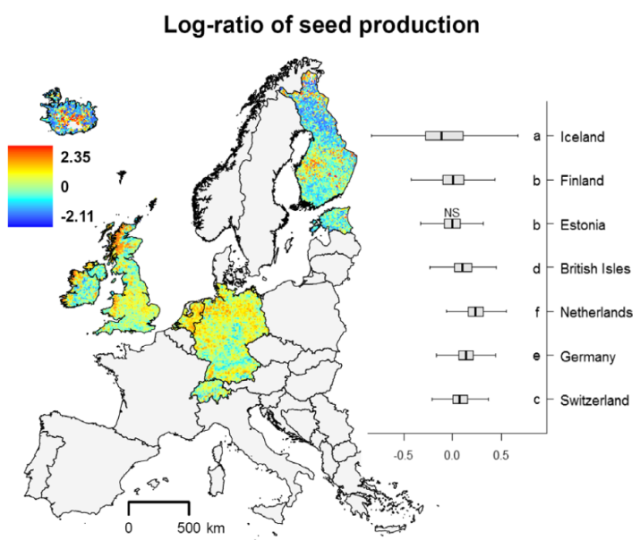autor Anton Zolotarjov
autor Anton Zolotarjov
autor Linda-Liisa Veromann-Jürgenson
autor Kersti Püssa
autor Anton Zolotarjov
autor Anton Zolotarjov
autor Linda-Liisa Veromann-Jürgenson
autor Kersti Püssa
The inability of many plant species to disperse to environmentally suitable sites after the Last Glacial Maximum limits plant diversity within Europe. Dispersal may also limit species occupancy of potentially suitable sites within their distribution ranges, resulting in a large proportion of species being absent from those sites (i.e. these sites have high dark diversity). Dark diversity has already been mapped at the European scale (see Ronk et al.2015 and a blog post), however, in our recent study (Riibak et al. 2017, Journal of Biogeography) we take a step further to explore the ecological mechanisms determining large-scale dark diversity.
We used vegetation data on ca. 10 x 10 km grid cells across seven regions in Central and Northern Europe to compare dispersal-related traits of observed and dark diversity. Our results show that poor dispersal ability (i.e. low seed production and short dispersal distance) restricts largely species dispersal to potentially suitable sites in Europe (Fig. 1). However, dispersal limitation decreased with increasing human population size and agricultural land use, showing that human activities have helped to disperse many plant species in Europe.


Fig.1. The log-ratio of seed production (upper graph) and potential dispersal distance (lower graph) between observed and dark diversity. Positive values indicate that absent plant species produce fewer seeds and have shorter potential dispersal distance than observed species (i.e. dispersal limited sites). Different lower case letters in the graph indicate significant differences between study areas.
Our results also indicate that the importance of dispersal limitation decreases either with strong abiotic stress or biotic resistance by resident vegetation. This means that in very stressful conditions, biodiversity is rather restricted by the establishment of poorly adapted species than dispersal. If the global change will be accompanied by warmer and moister conditions at high latitudes, dispersal limitation may become more dominant in the sparsely human inhabited regions of Northern Europe.
Citation: Riibak, K., Ronk, A., Kattge, J., Pärtel, M. (2017) Dispersal limitation determines large-scale dark diversity in Central and Northern Europe. Journal of Biogeography, doi: 10.1111/jbi.13000 (link to full text)

The square means of dispersal (pic from here)
Abstract:
Previous studies indicate that many plant species present in a surrounding region are absent from potentially suitable sites (i.e. they constitute dark diversity). However, quantitative analyses are lacking where and why dispersal limitation occurs within species occurrence range at the continental scale. We test if species characteristics related to dispersal limitation, that is, low seed production and short potential dispersal distance, affect the formation of dark diversity at large spatial scales. In addition, we explore how the levels of dispersal limitation are affected by climate, landscape heterogeneity and anthropogenic activity.
Seven study areas in Central and Northern Europe – Iceland, Finland, Estonia, the British Isles, the Netherlands, Germany and Switzerland.
We used data on vascular plant species occurrences in ca. 10 × 10 km grid cells from each study area. To estimate dark diversity for each grid cell, we applied geographical, biogeographical and environmental filters. Seed production was estimated directly (number of seeds per ramet), and indirectly from seed mass. We used several plant traits in combination (e.g. dispersal syndrome and seed characteristics) to estimate potential dispersal distance of seeds.
Species contributing to dark diversity produced generally fewer seeds and had shorter potential dispersal distances than observed species. Dispersal limitation tended to decrease with increasing environmental stress, human population density and agricultural land use.
Many species are absent from potentially suitable sites in Central and Northern Europe because of dispersal limitation, induced by low seed production and short potential dispersal distances. However, strong abiotic stress, biotic resistance and human activities have reduced the importance of dispersal limitation. This knowledge can be considered in the predictions of how changes in climate and land use affect biodiversity in the future.